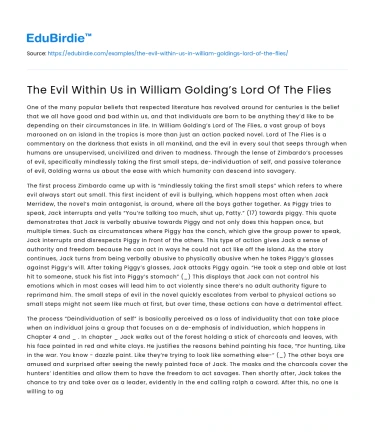One of the many popular beliefs that respected literature has revolved around for centuries is the belief that we all have good and bad within us, and that Individuals are born to be anything they’d like to be depending on their circumstances in life. In William Golding’s Lord of The Flies, a vast group of boys marooned on an island in the tropics is more than just an action packed novel. Lord of The Flies is a commentary on the darkness that exists in all mankind, and the evil in every soul that seeps through when humans are unsupervised, uncivilized and driven to madness. Through the lense of Zimbardo’s processes of evil, specifically mindlessly taking the first small steps, de-individuation of self, and passive tolerance of evil, Golding warns us about the ease with which humanity can descend into savagery.
The first process Zimbardo came up with is “mindlessly taking the first small steps” which refers to where evil always start out small. This first incident of evil is bullying, which happens most often when Jack Merridew, the novel’s main antagonist, is around, where all the boys gather together. As Piggy tries to speak, Jack interrupts and yells “You’re talking too much, shut up, Fatty.” (17) towards piggy. This quote demonstrates that Jack is verbally abusive towards Piggy and not only does this happen once, but multiple times. Such as circumstances where Piggy has the conch, which give the group power to speak, Jack interrupts and disrespects Piggy in front of the others. This type of action gives Jack a sense of authority and freedom because he can act in ways he could not act like off the island. As the story continues, Jack turns from being verbally abusive to physically abusive when he takes Piggy’s glasses against Piggy’s will. After taking Piggy’s glasses, Jack attacks Piggy again. “He took a step and able at last hit to someone, stuck his fist into Piggy’s stomach” (_) This displays that Jack can not control his emotions which in most cases will lead him to act violently since there’s no adult authority figure to reprimand him. The small steps of evil in the novel quickly escalates from verbal to physical actions so small steps might not seem like much at first, but over time, these actions can have a detrimental effect.
Save your time!
We can take care of your essay
- Proper editing and formatting
- Free revision, title page, and bibliography
- Flexible prices and money-back guarantee
The process “Deindividuation of self” is basically perceived as a loss of individuality that can take place when an individual joins a group that focuses on a de-emphasis of individuation, which happens in Chapter 4 and _ . In chapter _ Jack walks out of the forest holding a stick of charcoals and leaves, with his face painted in red and white clays. He justifies the reasons behind painting his face, “For hunting, Like in the war. You know - dazzle paint. Like they’re trying to look like something else-“ (_) The other boys are amused and surprised after seeing the newly painted face of Jack. The masks and the charcoals cover the hunters’ identities and allow them to have the freedom to act savages. Then shortly after, Jack takes the chance to try and take over as a leader, evidently in the end calling ralph a coward. After this, no one is willing to agree with Jack causing Jack to run away into the forest, suggesting “anyone who wants to hunt when I do can come too.” (_) Knowing the significance of this scene is important due to the fact that the boys separate into two groups, the problem of the “beast” still lingers and the disaster is commencing to change order. When individuals are amongst a large amount of people, they often get caught up in the heat of the moment and fall short of sanity finding themselves caught up in a mob mentality.
The last process of “seven processes that grease the slippery slope of evil’ is passive tolerance of evil through inaction and indifference. This process occurs in the book where Jack proudly and confidently shows his wound to the crowd, after killing a boar. As the hunters chant and dance, they begin to jab at Robert with their spears. “All at once, Robert was screaming and struggling with the strength of frenzy. Jack had him by the hair and was brandishing his knife. The chant rose ritually, as the last moment of a dance” (125) The characterization of Jack and his hunters cautions the readers towards the destructive impulses that reside inside all humans, where the hunters’ chant and dance pushes them to the brink of actual murder. Another scene that supports this process is when the hunters follow Jack’s lead to “kill the beast! Cut his throat! Spill his blood” (168) where they end up killing who they thought was the “beast”, but was actually Simon. “At once the crowd surged after it, poured down the rock, leapt on to the beast, screamed, struck, bit, tore” (169) At this stage, Jack and his followers are nothing but barbaric, bloodlust savages who now have the ability to commit villainous crime with a clear conscience. Because of Simon’s death, we finally see how tolerating evil leads to more catastrophic events, and when good people do nothing while depravity reigns, our communities will be devoured by the likes of savagery.
To sum up everything that has been stated, Philip Zimbardo’s seven social processes, particularly taking the first small steps, de-individuation of self, and passive tolerance of evil impacted and influenced the boys on the island. These processes intend to alert us how humanity can easily turn into savagery. Jack and his hunters’ way of thinking warns us how people possess a destructive instinct that could potentially damage other human beings.






 Stuck on your essay?
Stuck on your essay?

